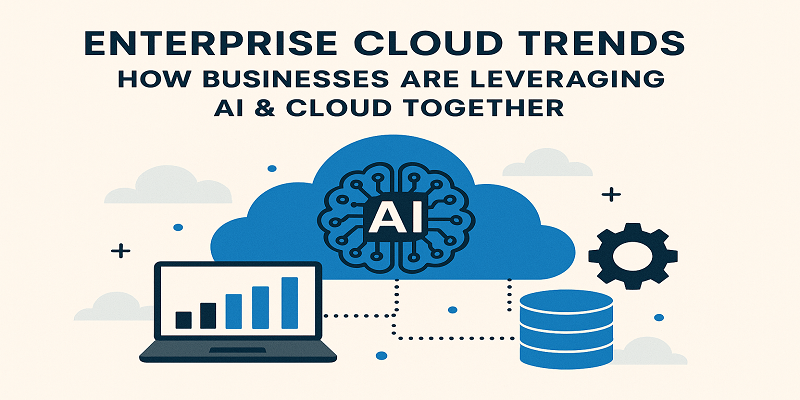Artificial Intelligence and cloud computing have evolved from standalone technologies into an inseparable duo driving the future of enterprise transformation. In 2025, this relationship is powering agile, data-driven, and cost-efficient ecosystems where businesses innovate faster, operate smarter, and scale globally.
As cloud adoption reaches maturity, enterprises are no longer just migrating workloads—they are weaving AI capabilities directly into their cloud architectures to extract real-time insights, automate processes, and create personalized customer experiences. Let’s explore how this synergy is reshaping enterprise operations and what trends are defining the AI–cloud revolution.
The Rise of AI-Driven Cloud Ecosystems
Modern enterprises rely on cloud infrastructure as the backbone for storing, managing, and processing massive data volumes. However, the growing complexity of data has made AI indispensable. AI models analyze information at scale, detect patterns, and recommend optimal decisions—capabilities that align perfectly with the flexibility and scalability of the cloud.
The cloud offers on-demand computational power and GPU resources necessary for AI training and inference. This combination allows enterprises to operationalize AI across departments without heavy upfront investments in hardware or IT infrastructure. Consequently, more organizations are embracing “AI-first cloud strategies” that center around automation, predictive analytics, and intelligent workflows.
Key Trends Driving the AI–Cloud Convergence
1. AI-Enhanced Cloud Automation
Enterprises increasingly rely on AI to automate resource management within cloud environments. Predictive analytics models can forecast workloads, optimize resource allocation, and manage costs automatically. Self-healing cloud systems use AI to detect anomalies, identify potential failures, and trigger corrective actions before interruptions impact services.
This automation keeps enterprise operations lean, enhances uptime, and ensures that cloud systems dynamically adapt to evolving business demands.
2. Multi-Cloud Intelligence
Managing multiple cloud environments used to be a challenge. Now, AI is simplifying this complexity. Machine learning algorithms help orchestrate applications and data distribution across various cloud providers based on performance metrics, cost, and compliance requirements.
Enterprises can use AI-based decision engines to identify which workloads perform best on which cloud, thereby balancing efficiency, reducing vendor lock-in, and ensuring resilience.
3. Edge AI and Distributed Cloud
As data generation shifts increasingly to the edge—via IoT devices, sensors, and remote systems—enterprises are deploying AI models closer to where the data originates. The distributed cloud architecture supports this approach by enabling low-latency inference and faster decision-making.
For example, in manufacturing, edge-based AI systems identify production anomalies in real time; in healthcare, they assist diagnostics instantly without transmitting sensitive data back to central servers. This distributed intelligence is redefining industries that demand speed and locality.
4. Data Security with AI-Enabled Cloud
Data security remains a top enterprise concern. AI is transforming how organizations secure information in the cloud through intelligent monitoring, anomaly detection, and behavior analytics. By continuously learning from network patterns, AI-powered systems can identify unusual access attempts and respond to threats immediately.
In tandem, cloud providers are integrating confidential computing and zero-trust security models supported by AI to protect sensitive workloads, paving the way for safer enterprise innovation.
5. AI-As-A-Service on Cloud
Many organizations do not have in-house AI expertise or infrastructure. Cloud platforms now offer pre-trained AI models and APIs for image recognition, natural language processing, and predictive analytics through AI-as-a-Service (AIaaS).
This democratization allows businesses of all sizes to integrate advanced AI capabilities into their existing workflows—whether it’s for customer service chatbots, fraud detection, or supply chain optimization—without building systems from scratch.
Business Impact: Reimagining Enterprise Efficiency
The combined force of AI and cloud is helping enterprises address key business imperatives—speed, scalability, and insight.
- Faster Innovation: AI development cycles benefit from the cloud’s elastic resources, reducing experimentation costs and deployment time for new products.
- Operational Efficiency: Intelligent cloud systems automate manual processes such as performance tuning and system health checks, freeing IT teams for strategic work.
- Customer Centricity: AI-enabled analytics in the cloud provides businesses with a 360-degree view of customer behavior, enabling hyper-personalized experiences.
- Sustainability: Smart cloud systems optimize energy usage, contributing to greener IT operations—a growing concern for enterprises pursuing ESG goals.
The synergy between AI and cloud computing also allows organizations to make data-driven decisions in real time. AI models hosted in cloud environments can process global datasets from diverse sources, turning operational noise into actionable insights.
Future Outlook: AI-Cloud Synergy in Action
As this convergence matures, several trends are likely to define the future enterprise tech stack:
- Generative AI on Cloud Platforms: Enterprises are deploying generative AI models via scalable cloud infrastructure to generate synthetic data, automate content creation, and enhance customer interaction tools.
- Industry-Specific Cloud AI Solutions: Sector-focused AI-cloud services—such as predictive maintenance for manufacturing or risk analytics in finance—are emerging to provide domain-optimized performance.
- Serverless AI Workloads: With serverless computing, organizations can run AI inferences without managing backend infrastructure, paying only for execution time, and dramatically improving cost efficiency.
- AI Governance and Compliance: Cloud-based governance tools will play a crucial role in ensuring AI systems are ethical, explainable, and compliant with evolving global data regulations.
By 2030, analysts expect nearly every enterprise cloud deployment to feature some degree of built-in AI capability—enabling intelligent automation, enhanced analytics, and adaptive services across every business layer.
Conclusion
The fusion of AI and cloud computing marks the dawn of a new enterprise era—one where intelligence, scalability, and agility coexist by design. Businesses are moving beyond traditional IT modernization and into intelligent transformation, where AI amplifies the value of data and the cloud amplifies AI’s accessibility and reach.
In a hyper-competitive landscape, understanding and adopting these AI–cloud trends will be crucial for organizations aiming to stay relevant, resilient, and ready for the next digital frontier.
